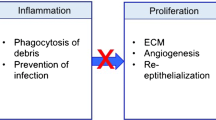Abstract:
Objective and design: To determine whether underlying mechanisms of inflammation, like cellular infiltrates, expression of adhesion molecule and cytokine patterns are similar under different conditions of injury. Skin biopsies were taken of three different groups of patients in which local inflammation of the skin might occur.¶Material, patients: Skin activation was studied as a result of incision during surgery under aseptic conditions, as a result of a local bacterial infection and as a result of blunt trauma, resulting in a femoral fracture, without disruption of the epithelial barrier.¶Methods: Skin biopsies were snap frozen for immunohistochemical analysis.¶Results: Incision of the skin resulted in a granulocyte infiltrate, paralleled by E-selectin expression. As a result of infection granulocytes were observed and monocyte/macrophage and T cell numbers were increased. Furthermore, E-selectin, VCAM-1 and ICAM-1 expression increased and cytokine expression markedly changed compared to normal skin. Skin taken at the site of the femoral fracture showed no signs of inflammation.¶Conclusion: Different stimuli lead to different local inflammatory responses in human skin.
Similar content being viewed by others
Author information
Authors and Affiliations
Additional information
Received 20 September 2000; returned for revision 11 November 2000; accepted by G. Letts 26 February 2001
Rights and permissions
About this article
Cite this article
van der Laan, N., de Leij, L. & ten Duis, H. Immunohistopathological appearance of three different types of injury in human skin. Inflamm. res. 50, 350–356 (2001). https://doi.org/10.1007/PL00000255
Issue Date:
DOI: https://doi.org/10.1007/PL00000255




